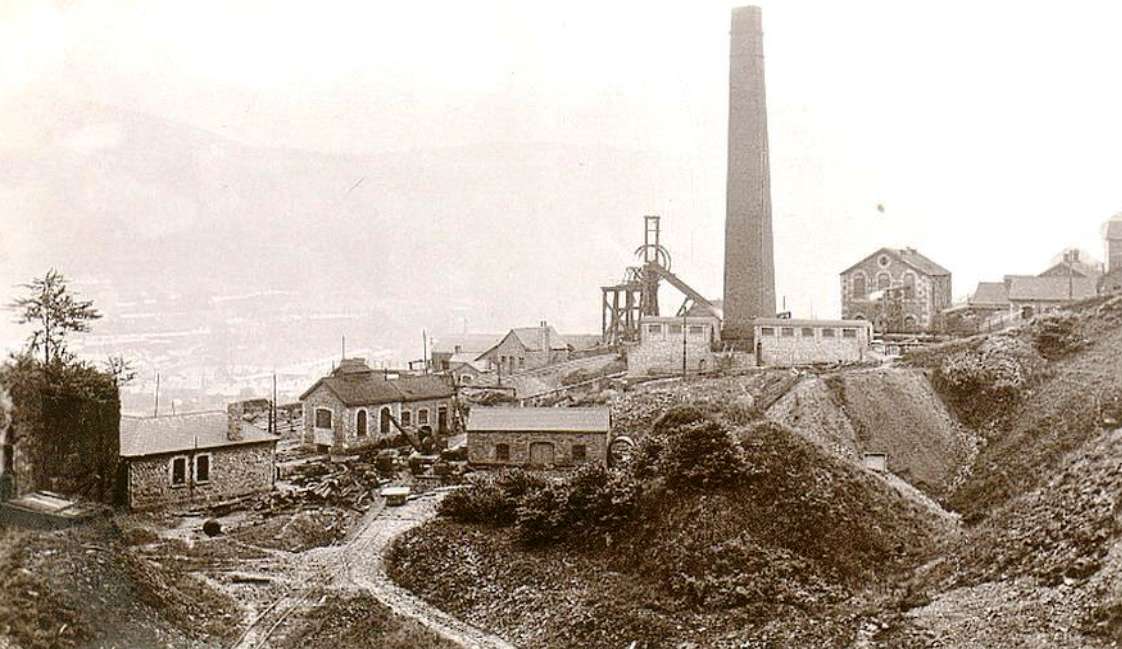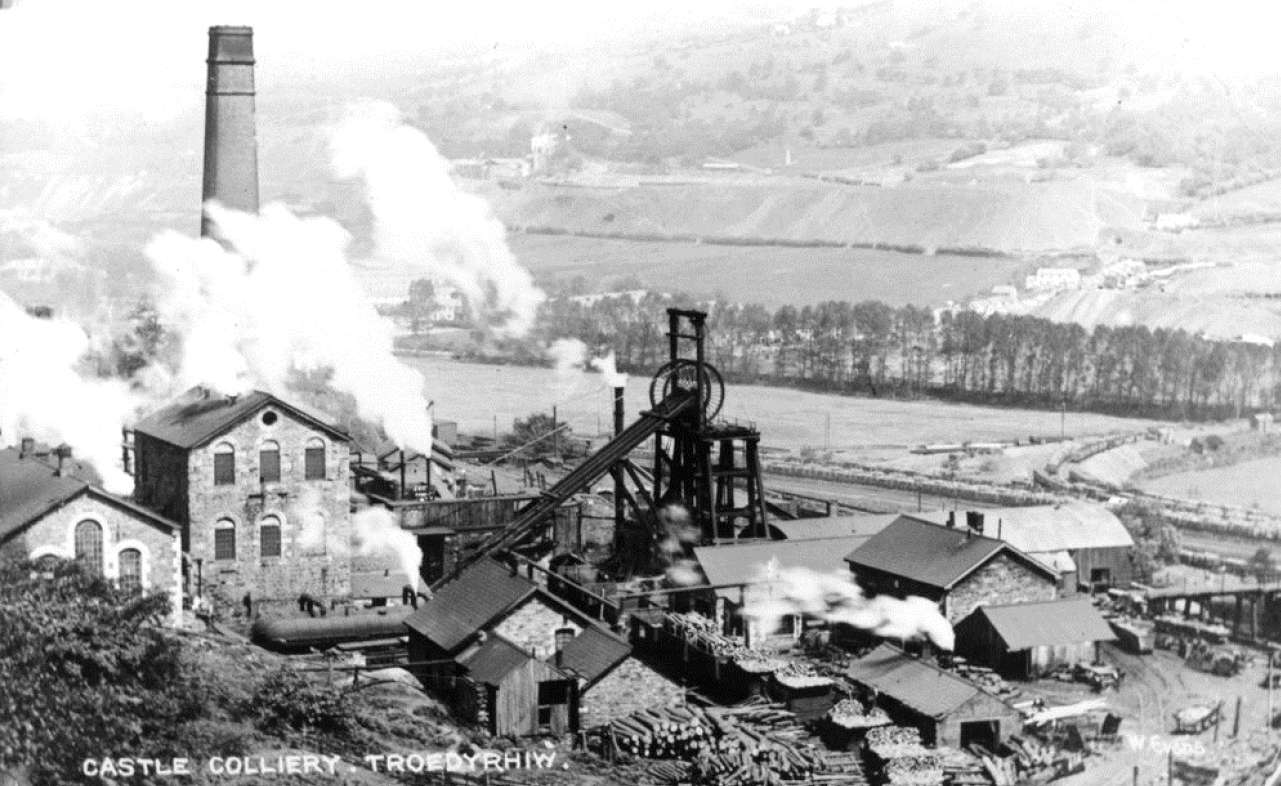Troedyrhiw (06470262)
 This pit was sunk to a depth of 333 yards to work the steam coal seams in 1866 by the Crawshay Brothers (Cyfarthfa) Company and by 1878 it was managed by M. Bates. The main winding engine was steam driven and consisted of a pair of 36 inches in diameter vertical cylinders and a 4 foot 6 inch stroke. The diameter of the winding drum was 12 feet with flat wire ropes being used. The cages were double-decked and could complete a wind from a depth of 263 yards in 90 seconds.
This pit was sunk to a depth of 333 yards to work the steam coal seams in 1866 by the Crawshay Brothers (Cyfarthfa) Company and by 1878 it was managed by M. Bates. The main winding engine was steam driven and consisted of a pair of 36 inches in diameter vertical cylinders and a 4 foot 6 inch stroke. The diameter of the winding drum was 12 feet with flat wire ropes being used. The cages were double-decked and could complete a wind from a depth of 263 yards in 90 seconds.
At 12.30 am on the 10th of July 1895, an explosion of methane gas killed Daniel Sullivan aged 23 years, Robert Bodger aged 29 and Samuel W. Thomas aged 18 years.
In 1896 the pit employed 571 men underground and 115 men on the surface with the manager being William Dyer. In 1908 the manager was David Francis and it employed 1,084 men underground and 188 men on the surface while the Castle Level employed 90 men underground and 11 men on the surface. In 1913 it employed 1,361 men and was still managed by David Francis. In 1916 the Pit employed 1,172 men and the levels employed 97 men. In 1918 David Francis was still the manager with the Pit employing 1,165 men underground and 190 men on the surface and the Level employed 72 men underground and 12 men on the surface. In 1919 the pit employed 1,330 men and the levels employed 81 men. In 1923 Mr. Francis was still the manager.
The level was abandoned in May 1927. In vertical total, this pit had over 64 feet of coal to work, of which 41 feet were in seams of over two feet in thickness.
 The Gorllwyn seam was 18 inches thick, the Two-Feet-Nine seam around 60 inches in thickness, the Upper-Four-Feet seam was 66 inches, the Six-Feet seam was 60 inches, the Seven-Feet seam 33 inches, while the Gellideg seam was 10 feet 7 inches of mixed coal and dirt. The Crawshay family came to dominate the Merthyr area and on the back of their iron and coal interests became one of the richest families in the world. It all started when a Yorkshireman called Richard Crawshay trekked to Merthyr Tydfil and bought the Cyfarthfa Iron Works and the mineral rights to 4,000 acres along with it. Before he died in 1810 Richard had developed the Works so it had become probably the largest one in the world. It was his grandson, William, who is credited with the sinking of the first pit in the area, the Mountain Pit, with another descendant, and perhaps the last of the ‘great’ Crawshays, Robert being the one to fully develop their coal mining business. He was also the one who had on his headstone “God, forgive me.” after he died in 1879. By 1925 the Castle Pit was owned by Llewellyn (Cyfarthfa) Limited who in 1930 were working the Castell-y-Weiver, Four-Feet, Six-Feet, Seven-Feet, Nine-Feet and Lower Four-Feet seams. In 1932 the manager was still T.J. Sims while in 1934 it employed 130 men on the surface and 900 men underground producing 270,000 tons of coal at this pit. The following year Powell Duffryn Associated Collieries Limited took control of the pit and stopped production.
The Gorllwyn seam was 18 inches thick, the Two-Feet-Nine seam around 60 inches in thickness, the Upper-Four-Feet seam was 66 inches, the Six-Feet seam was 60 inches, the Seven-Feet seam 33 inches, while the Gellideg seam was 10 feet 7 inches of mixed coal and dirt. The Crawshay family came to dominate the Merthyr area and on the back of their iron and coal interests became one of the richest families in the world. It all started when a Yorkshireman called Richard Crawshay trekked to Merthyr Tydfil and bought the Cyfarthfa Iron Works and the mineral rights to 4,000 acres along with it. Before he died in 1810 Richard had developed the Works so it had become probably the largest one in the world. It was his grandson, William, who is credited with the sinking of the first pit in the area, the Mountain Pit, with another descendant, and perhaps the last of the ‘great’ Crawshays, Robert being the one to fully develop their coal mining business. He was also the one who had on his headstone “God, forgive me.” after he died in 1879. By 1925 the Castle Pit was owned by Llewellyn (Cyfarthfa) Limited who in 1930 were working the Castell-y-Weiver, Four-Feet, Six-Feet, Seven-Feet, Nine-Feet and Lower Four-Feet seams. In 1932 the manager was still T.J. Sims while in 1934 it employed 130 men on the surface and 900 men underground producing 270,000 tons of coal at this pit. The following year Powell Duffryn Associated Collieries Limited took control of the pit and stopped production.
In 1934 Llewellyn (Cyfarthfa) Limited was based at Troedyrhiw with the directors being; Sir David R. Llewellyn, W.M. Llewellyn, H.H. Merrett, Sir John F. Beale, T.J. Callaghan and J.H. Jolly. The Castle and Berry Level were its only mines. It was linked to the South Duffryn Colliery, the main seams worked at Castle were; Four-Feet, Six-Feet, Seven-Feet, Nine-Feet, Red Vein and the Lower-Four-Feet. Based on the Nine-Feet seam this colliery’s coals were classed as types 202 and 203 Coking Steam Coals, weak to medium, low volatile, with low ash and sulphur content. They were used for steam-raising and coking purposes.
It was used as a pumping station by the National Coal Board which employed 5 men there in 1947.
Some of those who died at this mine:
- 7/4/1868, David Davies, aged 40, mason, run over by trams.
- 27/3/1872, John Evans, aged 26, timber man, roof fall.
- 23/4/1874, J. Jones, aged 27, collier, roof fall.
- 1/6/1879, Daniel Rees, aged 22, collier, roof fall.
- 6/5/1881, William Lewis, aged 39, collier, roof fall.
- 3/1/1882, Michael Connell, aged 40, sinker, shaft incident.
- 2/5/1882, Thomas Jones, aged 19, haulier, roof fall.
- 9/1/1883, Henry Davies, aged 18, collier, roof fall.
- 30/5/1883, Thomas Morgan, aged 12, door boy, run over by trams.
- 13/8/1883, William Harding, aged 20, haulier, run over by trams.
- 5/2/1885, John Davies, aged 63, collier, crushed by trams.
- 12/2/1885, Thomas Williams, aged 17, collier, roof fall.
- 30/5/1885, David Davies, aged 53, collier, roof fall.
- 7/8/1885, John Jenkins, aged 46, carpenter, scratched by wire rope.
- 2/6/1887, Thomas Eaton, aged 47, collier, roof fall.
- 30/11/1887, Thomas Jones, aged 53, collier, roof fall.
- 10/12/1887, John Passmore, aged 16, engineman, caught in machinery.
- 6/12/1888, Thomas Morgan, door keeper, crushed by trams.
- 4/5/1890, Thomas R. Davies, aged 19, carpenter, shaft incident,
- 7/8/1890, William Jones, aged 21, rider, roof fall.
- 7/8/1890, William J. Jenkins, aged 13, door boy, run over by trams.
- 21/9/1891, James Edwards, aged 49, collier, roof fall.
- 1/10/1891, John Lewis, aged 38, collier, roof fall.
- 14/11/1891, William Richards, aged 45, timber man, hit with a pick.
- 22/6/1892, John Evans, aged 45, labourer, was knocked down by a horse.
- 26/8/1892, William Turner, aged 52, collier, roof fall.
- 25/10/1892, William J. Phillips, aged 14, door boy, knocked down by a horse.
- 2/4/1893, Thomas Jones, aged 59, labourer, haulage incident.
- 21/5/1893, William Thomas, aged 73, labourer, shaft incident.
- 2/3/1910, Joseph Allen, aged 23, haulier, run over by trams.
Some Statistics:
- 1889: Output: 143,339 tons.
- 1894: Output: 145,591 tons.
- 1896: Manpower: 686.
- 1899: Manpower: 650.
- 1900: Manpower: Pit: 675. Level: 47.
- 1901: Manpower: Pit: 632. Level: 46.
- 1902: Manpower: Pit: 742. Level: 83.
- 1903: Manpower: Pit: 902. Level: 81.
- 1905: Manpower: Pit: 996. Level: 91.
- 1907: Manpower: Pit: 1,128. Level: 90.
- 1908: Manpower: Pit: 1,372. Level:90.
- 1909: Manpower: Pit: 1,272. Level:101.
- 1910: Manpower: Pit: 1,454. Level: 114.
- 1911: Manpower: Pit: 1,286. Level:115.
- 1912: Manpower: Pit: 1,385. Level: 119.
- 1913: Manpower: 1,361.
- 1915: Manpower: Pit: 1,281. Level: 135.
- 1916: Manpower: Pit: 1,172. Level: 97.
- 1918: Manpower: Pit: 1,356. Level: 86.
- 1919: Manpower: Pit: 1,330. Level: 81.
- 1922: Manpower: Pit: 1,512. level: 111.
- 1923: Manpower: Pit: 1,594. Level: 114.
- 1924: Manpower: Pit: 1,392. Level: 61.
- 1925: Manpower: 1,462.
- 1926: Manpower: 650.
- 1927: Manpower: Pit: 926. Level: 32.
- 1928: Manpower: Pit: 878 with Cethin.
- 1929: Manpower: Pit: 900.
- 1930: Manpower: Pit: 800. Level: 150.
- 1933: Manpower: Pit: 282.
- 1934: Manpower: Pit: 1,030. Output: 270,000 tons.
Information supplied by Ray Lawrence and used here with his permission.
Return to previous page
